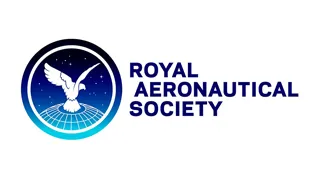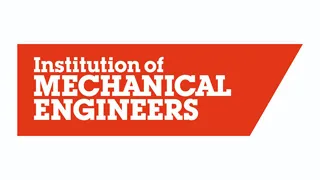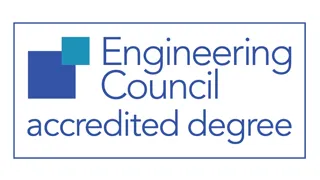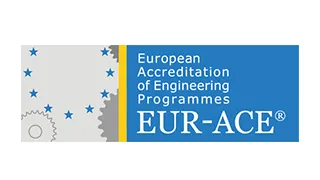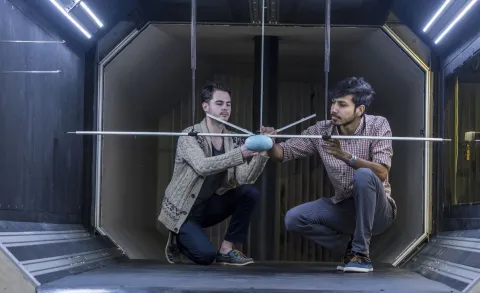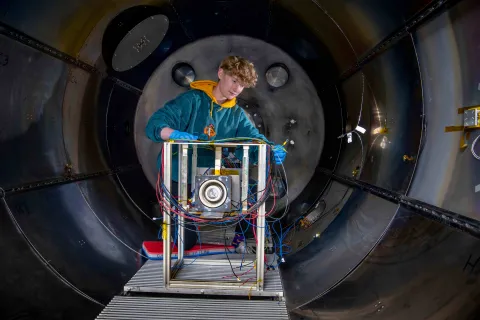About this course
Learn to design future aircraft, race cars, rockets and satellites, and launch into an exciting engineering career. Our advanced courses cover advanced aerospace engineering including the design and manufacture of fast-moving aircraft and spacecraft.
This MEng degree looks at the science, engineering and manufacture of aircraft and spacecraft. You'll learn how they operate within our atmosphere and in space, as well as the economic, legal and environmental issues associated with them. Your degree will be aligned to the UK Space Agency Civil Space Strategy.
You’ll study the principles of aeronautical and astronautical engineering, then take more advanced modules. In your second year you can choose if you want to specialise your degree. In year 3 you will complete an individual research project. In year 4 you’ll take part in a group design project.
You’ll get hands-on experience in our extensive facilities, which include:
- dedicated student design studios and workshops
- the largest wind tunnel in any UK university
- state-of-the-art space propulsion facilities
- jet laboratory with supersonic ramjet, turbojet and rocket engine
- Boeing flight simulator
- professional manufacturing centre
As part of this astronautics and aeronautics integrated master's degree you can:
- take part in practical design modules in every year of your degree
- design, build and test aircraft, spacecraft and their wider components
- take part in a flight-testing course, on board a flying laboratory aircraft
- showcase your work in our annual Engineering Design Show
- attend site visits to experience engineering in practice
Year in industry
Enhance your employability by taking this course with a paid industrial placement year.
Apply using:
- Course name: Aeronautics and Astronautics with Industrial Placement Year
- UCAS code: H414
You'll spend this extra year at an engineering firm, applying the skills and knowledge you've learned so far.
The fee is 20% of the standard annual tuition fee.
Study this course in Malaysia
You can also study this course at University of Southampton Malaysia.
Find out more about our Malaysia courses and how to apply
We regularly review our courses to ensure and improve quality. This course may be revised as a result of this. Any revision will be balanced against the requirement that the student should receive the educational service expected. Find out why, when, and how we might make changes.
Our courses are regulated in England by the Office for Students (OfS).
Accreditations
This course is accredited by the Royal Aeronautical Society (RAeS) and the Institution of Mechanical Engineers (IMechE) as meeting the academic requirement, in full, for Chartered Engineer registration.
This course is accredited by:
Introducing Aeronautical and Astronautical Engineering
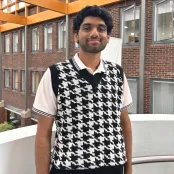
Work experience programmes offered by the University are a great opportunity to gain essential skills that will come in handy for your future.
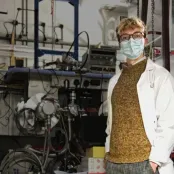
The space industry is incredibly valuable to climate scientists. Without satellites we would know so little about what causes climate change and how to combat it.
Course locations
This course is based at Highfield and Boldrewood.
Awarding body
This qualification is awarded by the University of Southampton.
Download the Course Description Document
The Course Description Document details your course overview, your course structure and how your course is taught and assessed.
Entry requirements
For Academic year 202627
A-levels
A*AA including mathematics (minimum grade A) and physics (minimum grade A), with a pass in the physics Practical (where it is separately endorsed).
A-levels additional information
Offers typically exclude General Studies and Critical Thinking.
Applicants who have not studied mathematics and/or physics at A-level can apply for the Engineering/Physics/Mathematics Foundation Year
A-levels with Extended Project Qualification
If you are taking an EPQ in addition to 3 A levels, you will receive the following offer in addition to the standard A level offer: AAA including mathematics and physics, with a pass in the physics Practical (where it is separately endorsed) plus grade A in the EPQ
A-levels contextual offer
We are committed to ensuring that all learners with the potential to succeed, regardless of their background, are encouraged to apply to study with us. The additional information gained through contextual data allows us to recognise a learner’s potential to succeed in the context of their background and experience. Applicants who are highlighted in this way will be made an offer which is lower than the typical offer for that programme as follows:
AAB including mathematics (minimum grade A) and physics (minimum grade A), with a pass in the physics Practical (where it is separately endorsed).
International Baccalaureate Diploma
Pass, with 38 points overall with 19 points required at Higher Level, including 6 at Higher Level in Physics and 6 at Higher Level in Mathematics (Analysis and Approaches) or 7 at Higher Level in Mathematics (Applications and Interpretation)
International Baccalaureate Diploma additional information
Applicants who have not studied the required subjects can apply for the Engineering/Physics/Mathematics Foundation Year
International Baccalaureate contextual offer
We are committed to ensuring that all learners with the potential to succeed, regardless of their background, are encouraged to apply to study with us. The additional information gained through contextual data allows us to recognise a learner’s potential to succeed in the context of their background and experience. Applicants who are highlighted in this way will be made an offer which is lower than the typical offer for that programme.
International Baccalaureate Career Programme (IBCP) statement
Offers will be made on the individual Diploma Course subject(s) and the career-related study qualification. The CP core will not form part of the offer. Where there is a subject pre-requisite(s), applicants will be required to study the subject(s) at Higher Level in the Diploma course subject and/or take a specified unit in the career-related study qualification. Applicants may also be asked to achieve a specific grade in those elements. Please see the University of Southampton International Baccalaureate Career-Related Programme (IBCP) Statement for further information. Applicants are advised to contact their Faculty Admissions Office for more information.
BTEC
RQF BTEC
D in the BTEC National Extended Certificate plus grades A*A in A-level mathematics and physics (the A* can be in either subject), with a pass in the physics Practical (where it is separately endorsed).
or
D* in the BTEC National Extended Certificate plus grades AA in A-level mathematics and physics, with a pass in the physics Practical (where it is separately endorsed).
We will consider the BTEC National Diploma if studied alongside A-levels in mathematics and physics.
We will consider the BTEC National Extended Diploma in Engineering if studied alongside A-level mathematics.
We are committed to ensuring that all learners with the potential to succeed, regardless of their background, are encouraged to apply to study with us. The additional information gained through contextual data allows us to recognise a learner’s potential to succeed in the context of their background and experience. Applicants who are highlighted in this way will be made an offer which is lower than the typical offer for that programme.
Additional information
Offers typically exclude General Studies and Critical Thinking.
Applicants who have not studied mathematics and/or physics at A-level can apply for the Engineering/Physics/Mathematics Foundation Year
QCF BTEC
D in the BTEC Subsidiary Diploma plus A*A in A-level mathematics and physics (the A* can be in either subject), with a pass in the physics Practical (where it is separately endorsed).
or
D* in the BTEC Subsidiary Diploma plus AA in A-level mathematics and physics, with a pass in the physics Practical (where it is separately endorsed).
We will consider the BTEC Diploma if studied alongside A-levels in mathematics and physics.
We will consider the BTEC Extended Diploma in Engineering if studied alongside A-level mathematics.
BTEC contextual
We are committed to ensuring that all learners with the potential to succeed, regardless of their background, are encouraged to apply to study with us. The additional information gained through contextual data allows us to recognise a learner’s potential to succeed in the context of their background and experience. Applicants who are highlighted in this way will be made an offer which is lower than the typical offer for that programme.
Access to HE Diploma
Not accepted for this course. Applicants with an Access to HE Diploma in a relevant subject should apply for the Engineering/Physics/Mathematics Foundation Year
Access Offer Contextual
We are committed to ensuring that all learners with the potential to succeed, regardless of their background, are encouraged to apply to study with us. The additional information gained through contextual data allows us to recognise a learner’s potential to succeed in the context of their background and experience. Applicants who are highlighted in this way will be made an offer which is lower than the typical offer for that programme.
Irish Leaving Certificate
Irish Leaving Certificate (first awarded 2017)
H1 H1 H1 H2 H2 H2 including mathematics, applied mathematics and physics
Irish certificate additional information
Applicants who have not studied the required subjects can apply for the Engineering/Physics/Mathematics Foundation Year
Irish Offer Contextual
We are committed to ensuring that all learners with the potential to succeed, regardless of their background, are encouraged to apply to study with us. The additional information gained through contextual data allows us to recognise a learner’s potential to succeed in the context of their background and experience. Applicants who are highlighted in this way will be made an offer which is lower than the typical offer for that programme.
Scottish Qualification
Offers will be based on exams being taken at the end of S6. Subjects taken and qualifications achieved in S5 will be reviewed. Careful consideration will be given to an individual’s academic achievement, taking in to account the context and circumstances of their pre-university education.
Please see the University of Southampton’s Curriculum for Excellence Scotland Statement (PDF) for further information. Applicants are advised to contact their Faculty Admissions Office for more information.
Welsh Baccalaureate
A*AA including mathematics (minimum grade A) and physics (minimum grade A), with a pass in the physics Practical (where it is separately endorsed) or A*A from two A levels including mathematics and physics (the A* can be in either subject), with a pass in the physics Practical (where it is separately endorsed) and A from the Advanced Skills Baccalaureate Wales.
Welsh Baccalaureate additional information
Offers typically exclude General Studies and Critical Thinking.
Applicants who have not studied mathematics and/or physics at A-level can apply for the Engineering/Physics/Mathematics Foundation Year
Welsh Baccalaureate contextual offer
We are committed to ensuring that all applicants with the potential to succeed, regardless of their background, are encouraged to apply to study with us. The additional information gained through contextual data allows us to recognise an applicant's potential to succeed in the context of their background and experience. Applicants who are highlighted in this way will be made an offer which is lower than the typical offer for that programme.
T-Level
Not accepted for this course. Applicants with a T level Technical Qualification in a relevant subject can apply for the Engineering/Physics/Mathematics Foundation Year
Other requirements
GCSE requirements
Applicants must hold GCSE English language (or GCSE English) (minimum grade 4/C) and mathematics (minimum grade 4/C)
Find the equivalent international qualifications for our entry requirements.
English language requirements
If English is not your first language, you must show that you can use English to the level we require. Visit our English language pages to find out which qualifications we accept and how you can meet our requirements.
If you are taking the International English Language Testing System (IELTS), you must get at least the following scores:
IELTS score requirements
- overall score
- 6.5
- reading
- 6.0
- writing
- 6.0
- speaking
- 6.0
- listening
- 6.0
If you do not meet the English language requirements through a test or qualification, you may be able to meet them by completing one of our pre-sessional English programmes before your course starts.
You might meet our criteria in other ways if you do not have the qualifications we need. Find out more about:
- our Ignite your Journey scheme for students living permanently in the UK (including residential summer school, application support and scholarship)
- skills you might have gained through work or other life experiences (otherwise known as recognition of prior learning)
Find out more about our Admissions Policy.
Foundation year for engineering, physics, maths and geophysics
A foundation year will give you the skills and knowledge to progress to this course if you don't have the right qualifications for direct entry.
It could be the right option if you:
- have A levels, or equivalent international qualifications, in subjects other than the ones needed for direct entry
- have international qualifications in relevant subjects but not at A level equivalent
- have a BTEC Extended Diploma in a relevant subject
- are studying an Access course in a relevant subject
- are a mature student with relevant experience or study
You'll also need to show that you have strong maths skills.
Find full details on our Engineering, Maths, Physics, Geophysics Foundation Year page.
Mature applicants
We welcome applications from learners of all ages. Students who are aged 21 and over at the start of their undergraduate course are defined as mature by the University of Southampton. We take a holistic assessment of the application looking for academic ability and commitment to study. Typical entry requirements, which may vary from discipline to discipline, includes for example, evidence of recent formal academic qualifications or professional qualifications, relevant work experience or volunteering. You may also be invited to attend an interview with an Admissions Tutor. For some degree programmes, there may also be a Professional, Statutory and Regulatory Body (PSRB) requirement. We accept many different academic qualifications. For more information, please contact the Admissions Team.
Got a question?
Please contact our enquiries team if you're not sure that you have the right experience or qualifications to get onto this course.
Email: enquiries@southampton.ac.uk
Tel: +44(0)23 8059 5000
Course structure
The first 2 years are the same across our Aeronautics and Astronautics degrees. They focus on core engineering science. In the third and fourth years, you'll take advanced modules and carry out a master's-level group design project.
This is a very practical course, with opportunities for practical engineering experience in each year.
You will visit industry and research establishments and learn workshop training and research techniques.
Year 1 overview
You'll take an induction programme that will give you your first practical experience and the opportunity to get to know your fellow students.
We'll develop your design and programming skills and teach you to build and test engineering systems, components and mechanisms.
You'll also learn manufacturing skills in our workshops so that you can make your ideas a reality.
Core modules include topics such as:
- aircraft operations and flight mechanics
- design and computing
- electrical and electronic systems
- mathematics
- thermofluids
Year 2 overview
You'll build on your core knowledge from the first year, and increases your focus on Aeronautics and Astronautics disciplines. Compulsory modules include:
- aerodynamics
- astronautics
- mechanics of flight
- propulsion
These modules feature hands-on teaching, using facilities such as our wind tunnels, turbojet and rocket engine.
You’ll take a systems design and computing module, and participate in a team project to design, create and test a robot, drone, responsive system or other device.
At the end of the second semester you’ll take a flight test course, in which experiments are performed on board a Jetstream aircraft.
Year 3 overview
You'll deepen your understanding of aircraft design, including their environmental impacts. Core modules include:
- aerothermodynamics
- aircraft structural design
- aerospace control design
You'll choose optional modules from topics including:
- applications of computational fluid dynamics (CFD)
- finite element analysis
You'll carry out an individual research project using many of the concepts that you've learnt over the previous 2 years. For example, students have investigated how to deflect asteroids, or use 3D-printed, metal jet engines.
Year 4 overview
You can tailor your degree by selecting advanced modules from a wide range of fields, such as:
- race car aerodynamics
- spacecraft structural design
- advanced computational methods
- aeroelasticity
- failure of materials and components
You’ll participate in a group design project - a chance to apply your conceptual engineering and scientific knowledge to an engineering design problem.
Previous projects include the design and development of a hybrid, tail-sitter aircraft for humanitarian aid missions and a fuel-efficient ion thruster for spacecraft. You can also create your own project. These projects are often linked to current research or supported by industry, like Airbus or the European Space Agency.
Want more detail? See all the modules in the course.
Modules
The modules outlined provide examples of what you can expect to learn on this degree course based on recent academic teaching. As a research-led University, we undertake a continuous review of our course to ensure quality enhancement and to manage our resources. The precise modules available to you in future years may vary depending on staff availability and research interests, new topics of study, timetabling and student demand. Find out why, when and how we might make changes.
For entry in academic year 2026 to 2027
Year 1 modules
You must study the following modules in year 1:
Aerospace Electronics
All modern aerospace systems rely upon electronic and mechatronic subsystems to sense, process and respond to their environment. Aerospace engineers need to be able to use a range of technologies and theory to design these responsive systems which add...
Aerospace Materials
This first-year module introduces the physical origins and properties of materials and explores how these properties govern their selection in aerospace engineering applications. A variety of materials will be studied, including metals and alloys, high-te...
Data Science & Computational Methods
“The purpose of computing is insight, not numbers” (Hamming, 1962). Data science is all about gaining insight from the large amounts of data we are surrounded by. In our digital world, engineers need to be able to use a range of tools, technologies an...
Introduction to Aeronautics & Astronautics
This is an introduction to Aeronautics and Astronautics, which lays down the foundations of all of the aeronautical and astronautical engineering modules that follow in subsequent years. * An introduction to aerospace systems, operations, safety and c...
Introduction to Aerospace Design
This module provides students with a comprehensive introduction to aerospace design by blending technical knowledge, creativity, and hands-on skills. Students will learn the full design process, from design requirements to concept development, geometry mo...
Mathematics for Engineering and the Environment
This course lays the mathematical foundation for all engineering degrees. Its structure allows students with different levels of previous knowledge to work at their own pace. Pre-requisite for MATH2048 One of the pre-requisites for MATH3081 and MATH...
Statics & Dynamics
This is a first module on mechanics of solids and dynamics, which lays down the foundations of all of the aerospace structural modules that follow in subsequent years and also provides an introduction to dynamics that would be pertinent to structural vibr...
Thermofluids for Aerospace Engineers
This module provides a foundational understanding of thermodynamics and fluid mechanics to Aeronautics and Astronautics Engineering students, placing significant emphasis on the critical application of these principles to aerospace systems. It equips stud...
Year 2 modules
You must study the following modules in year 2:
Advanced Aerospace Systems Design
The SESA2030 Systems Design and Computing module integrates practical and theoretical learning through lectures, tutorials, and hands-on prototyping exercises. It challenges students to collaboratively address mechatronic engineering design problems. This...
Aerodynamics
In this module the fundamental concepts of aerodynamics are introduced. The main focus is on inviscid, incompressible flow, but, viscous effects will also be covered. Finally, static stability of an aircraft is introduced. The lectures are complemented by...
Aerospace Materials & Structures
This second year module continues to develop the links between structures and materials, building on the fundamentals established in the first year course on mechanics, structures and materials. The relationship between composition, microstructure and pro...
Aerospace Mechanics & Control
This module introduces the fundamental concepts of aerospace mechanics and control including modelling, motion analysis, stability, characteristic motion response as well as design of control systems for aerospace vehicles. The main focus is on the thr...
Astronautics
This module introduces the fundamental concepts of astronautics and spacecraft engineering and applies the design approach to case studies based on Earth observation missions.
Digital Aerospace Methods
Aerospace design is a multidisciplinary task involving different disciplines, such as aerodynamics, structure, flight dynamics and performance, propulsion, etc. An accurate and reliable assessment of aircraft characteristics in various fields is essential...
Mathematics for Engineering and the Environment Part II
The module aims to teach mathematical methods relevant for engineering. The first part is about differential equations and how solve them, from ordinary differential equations to partial differential equations. The second part is about either vector calcu...
Propulsion
This module introduces the fundamental principles of aircraft propulsion, and covers air-breathing and rocket propulsion systems. The module focuses on the analysis and determination of thrust and performance criteria for propulsion systems such as ramjet...
Year 3 modules
You must study the following modules in year 3:
Advanced Aerospace Mechanics And Control
This module introduces advanced concepts of aerospace mechanics, dynamics and control. The main focus is on dynamics, modeling and control of systems that have multiple degrees of freedom. The first part of the module aims to express the 3 translationa...
Aerothermodynamics
Aerothemodynamics is essential to the design of high speed flight vehicles (in this context high speed refers to anything above about Mach 0.3). The subject integrates thermodynamics and fluid mechanics concepts to cover the fundamentals of compressible f...
Individual Project
The Individual Project is a learning experience that enables you to carry out research and bring together many of the concepts that you have learnt over the first two years of the course as well as the knowledge and skills learnt during part III. You w...
Management & Law for Aerospace Engineers
This module will provide students with the skills and knowledge necessary to: - Plan, cost and manage an engineering project in the presence of risk and uncertainty - Understand the role of stochastic & statistical modelling approaches in quantifying...
You must also choose from the following modules in year 3:
Advanced Aeronautics
Advanced Aeronautics further develops student’s knowledge in aerodynamics as applied to fixed wing aircraft and rotorcraft beyond the level achieved in Part II Aerodynamics, focusing on the application of basic fluid dynamics principles to flow over exter...
Advanced Astronautics
Advanced Astronautics picks up where year 2 Astronautics left off. In this module you will further study Orbital Mechanics, while learning about relevant requirements, norms, standards and best practices. You will apply this knowledge to sustainable sp...
Aircraft Structural Design
The module not only introduces the fundamental concepts of aircraft structural design but also provides the analytical and numerical tools to analyse complex aerospace systems within a multidisciplinary environment. Understanding and predicting the mutual...
Concurrent Space Systems Design
Concurrent Space Systems Design builds on the understanding and knowledge gained from the Astronautics modules in years 2 and semester 1 in year 3. You will learn how to place those “building blocks” of space engineering into the context of a group spacec...
Introduction to Aircraft Design
This is an aerospace design synthesis module. The aircraft operations, aerodynamics, mechanics of flight, mechanics of solids and propulsion modules of Part I and II having equipped the students with the building blocks of aerospace engineering science, t...
Spacecraft Structural Design
This module introduces the fundamental concepts of spacecraft structural design. It leads on from the basic static analysis of structures covered in part I and II and introduces the student to the static and dynamic analysis of satellite structures along ...
Year 4 modules
You must study the following modules in year 4:
Advanced Aerospace Engineering Management
This module will provide students with the skills and knowledge to model and manage reliability, risk, uncertainty & security at both the project and business level while educating students on their responsibilities to be both ethical and inclusive engine...
Group Design Project
This group project enables you to apply your conceptual engineering and science knowledge to an engineering design problem. The ideas are developed through detailed design, experimentation, computer modelling and/or manufacture. You will also consider and...
You must also choose from the following modules in year 4:
Advanced Computational Methods I
The module is focussed around advanced computational methods incorporating C and compiled languages, computational modelling and software engineering techniques for science and engineering. It builds on lower level courses such as FEEG1001 and FEEG2001 an...
Advanced Finite Element Analysis
This module is aimed at providing exposure to and understanding of advanced, specialist areas of Finite Element Analysis and their underlying Solid/Structural Mechanics concepts. It then concentrates on using this knowledge for solving discipline-specifi...
Advanced Photovoltaics, Fuel Cells and Batteries
This module aims to provide the understanding of solar cell operation, relevant optical structures, photovoltaic systems and advanced concepts for high efficiency and low cost. Charge carrier statistics and transport are discussed in detail with applicati...
Aeroacoustics
This module covers aerodynamic noise sources and sound propagation in moving media. Aeroacoustics is of great importance in engineering settings involving high speed flows, including transport (aeroplane, aeroengine, automobile, train), industrial proces...
Aeroelasticity
This module concerns structural dynamics and aeroelastic phenomena that can result in dangerous static and dynamic deformations and instabilities, particularly relevant in the design of modern aircraft and space vehicles. It builds on basic knowledge on f...
Aircraft Propulsion
This module develops aerodynamic and thermodynamic methods for design of gas turbine engines. Starting from considerations of aircraft requirements and basic thermodynamics and fluid mechanics, students learn how the overall engine design can be tailored ...
Applications of CFD
The basic concept of Computational Fluid Dynamics and numerical procedures (FVM/FDM) are introduced. The major focus is practical applications, including geometry and grid generation, using solvers and turbulence models in CFD packages, and interpretation...
Automotive Propulsion
Motorised transport has transformed many aspects of human life over the past 120 years. Today’s automotive engineers, however, face the unresolved challenge of continuing that transformation in a sustainable manner. Therefore this module develops the stud...
Composites Engineering Design and Mechanics
This module provides an in depth coverage of the mechanics of fibre-reinforced polymer materials and structures. The core of the course encompass modelling of the 2D orthotropic lamina reduced from 3D continuum mechanics for anisotropic solids, classical ...
Computational Aerodynamics
This module is concerned with the physical modelling and numerical methods required for calculations of aerodynamic forces and moments on moving objects. It is not exclusively a package-based computational fluid dynamics module. Instead, it focuses on mat...
Computational methods in biomedical engineering design
Computational methods play an ever increasing role for the successful development of cost-effective and robust engineering solutions to address the challenges emerging from a healthcare agenda calling for prolonging independent living and the personalisat...
Corporate Finance
This module provides a deep insight in some key theories and topics in Corporate Finance. The module looks at how firms and corporation manage financial investment and decisions in the long term and short term. The module will discuss topics ranging fro...
Data-Driven Fluid Mechanics
The module will introduce contemporary computational methods for fluid flow analysis, with a specific focus on techniques that use simulation or experimental data. The module will cover aspects of flow stability, model order reduction and pattern identifi...
Design Search and Optimisation (DSO) - Principles, Methods, Parameterizations and Case Studies
This module introduces students to formal design search and optimization (DSO) approaches using a mixture of lectures covering theory and practice and a series of worked case studies with student participation.
Experimental Methods for Aerodynamics
This module is aimed at students who will be performing aerodynamic or fluid mechanic experiments in their individual project, group design project and/or research project. You will gain insights on the problems associated with design, setup and execut...
Failure of Materials and Components
In this module, the emphasis moves away from alloy development and design, and focuses on the performance of structural materials in a range of engineering applications. The lectures draw on examples from applications of ceramics, steel, Al, Ti and Ni bas...
Finite Element Analysis in Solid Mechanics
Many real-world engineering structures are too complex for their behaviour to be understood using an ‘exact’ analytical or theoretical method alone. Therefore, in practice we often use approximate numerical or simulation-based tools for structural analysi...
Hypersonic & High Temperature Gas Dynamics
The module will provide the necessary background for those students interested in the design and operation of high speed aerospace vehicles, such as launch vehicles, re-entry vehicles and missiles.
Information Systems Management and Strategy
The purpose of this module is to equip students with a useful grounding in digital strategy and information systems (IS) management. After introducing the characteristics and concepts of systems and IS, the module will provide an overview of strategic pl...
Intelligent Mobile Robotics
This module teaches the theory and practice of robotic perception and reasoning needed for mobile autonomous vehicles to operate in dynamic, unstructured environments across land, sea and air. You will learn probabilistic methods so that robots can self-l...
Materials for Transport Applications
This module considers metallic alloys with special reference to applications in transport applications. The main materials considered are aluminium, titanium and nickel based alloys, and steel. Also metal based composites, and high temperature materials s...
Microstructural and Surface Characterisation
This module on microstructural analysis and surface characterisation of materials and components considers Surface Profilometry, transmission electron microscopy (TEM), scanning electron microscopy (SEM), optical microscopy, diffraction techniques, energy...
Nonlinear Control of Aerospace Systems
Modern (and future) aircraft employ a variety of nonlinear techniques to both design control systems and perform analysis of the arising closed-loop. This is due to the fact that aircraft dynamics are fundamentally nonlinear and also, with the widespread ...
Numerical Methods
Often in mathematics, it is possible to prove the existence of a solution to a given problem, but it is not possible to "find it". For example, there are general theorems to prove the existence and uniqueness of an initial value problem for an ordinary di...
Principles of Photovoltaics, Fuel Cells and Batteries
This module covers the aspects of design and operation of modern fuels cells and photovoltaic systems. It discusses the fundamentals, structure, materials and operation of these systems. Students attending this module are expected to have understood th...
Project Management
The global and rapid growth of managing by projects in every sector, industry, and company type has led to the development of pan-sector theories and bodies of knowledge in project management. The specific nature of projects as temporary and unique activi...
Project Risk Management
Project risk management has evolved significantly over many years, but there are conflicting views about what constitutes best practice. This course provides an overview of best practice as outlined in the course text with a critical comparison of alterna...
Race Car Aerodynamics
The student will gain insight on major aerodynamic features associated with vehicle and race car aerodynamics, including aerodynamics of overall car, aerodynamics of major devices, test facilities and experimental methods, test setup, etc. The most import...
Renewable Energy from Wind, Wave and Tide
The atmospheric and gravitational processes present on the earth generate flows of wind and water. This module studies these resources and practical methods/technologies for extracting cost-effective electrical and other energy conversions. The main focu...
Signal Processing
Signals such as audio, music, sonar, image and video convey information about physical quantities that vary over time and space. Signals can, for example, describe acoustic vibrations or radio waves, and thus play an important role throughout engineering....
Spacecraft Instrumentation
This module describes the development of spacecraft instrumentation, from the definition of the requirements to the final design and operation. You will also gain a good understanding of the interaction between the instrument and the platform and the spac...
Spacecraft Orbital Mechanics
This module introduces students to the fundamental concepts of spaceflight orbital mechanics and then elaborates on trajectory design for planet centred and interplanetary missions. It covers the design and characterisation of planet-centred orbits in ...
Spacecraft Propulsion
This module considers the basic theory and principles of operation of chemical and electric propulsion systems for spacecraft. Both solid and liquid propellant chemical propulsion systems are considered, as is a variety of electric propulsion systems util...
Strategic Management
Strategic management is central to the operation of a variety of businesses in different sectors and environments. The creation of a strategy and the management of its implementation are important in developing businesses that can create and sustain a com...
Strategic Operations Management
In the past, where organisations tended to be more hierarchical than today, the words, "strategy" and "operations" were almost mutually exclusive. In today's highly competitive environment, though, strategic operations capabilities must be in place in ord...
Sustainable energy systems, resources and usage
The module provides an understanding of general energy concepts and how to apply energy related techniques gained through specialist courses to every-day situations. We will also take a look at the energy flows around our planet and consider issues such a...
Turbulence
This module will provide an introduction to the fundamentals of turbulent flow . The focus will be on understanding the equations of motion and the underlying physics they contain. The goal will be to provide you with the tools necessary to continue the s...
Learning and assessment
The learning activities for this course include the following:
- lectures
- classes and tutorials
- coursework
- individual and group projects
- independent learning (studying on your own)
Course time
How you'll spend your course time:
Year 1
Study time
Your scheduled learning, teaching and independent study for year 1:
How we'll assess you
- dissertations
- essays
- oral presentations
- written and practical exams
- written exams
Your assessment breakdown
Year 1:
Year 2
Study time
Your scheduled learning, teaching and independent study for year 2:
How we'll assess you
- dissertations
- essays
- oral presentations
- written and practical exams
- written exams
Your assessment breakdown
Year 2:
Year 3
Study time
Your scheduled learning, teaching and independent study for year 3:
How we'll assess you
- dissertations
- essays
- oral presentations
- written and practical exams
- written exams
Your assessment breakdown
Year 3:
Year 4
Study time
Your scheduled learning, teaching and independent study for year 4:
How we'll assess you
- dissertations
- essays
- oral presentations
- written and practical exams
- written exams
Your assessment breakdown
Year 4:
Academic support
You’ll be supported by a personal academic tutor and have access to a senior tutor.
Course leader
Sean Symon is the course leader.
Careers and employability
Employability skills
This degree will allow you to develop and evidence subject-specific and targeted employability skills. This includes the required skill set for a range of future careers, further study, or starting your own business.
The skills you can expect to focus on and gain from this course include:
- Research
- Critical thinking
- Commercial awareness
- Self-management
- Confidence
- Leadership
- Communication
- Teamwork
- Creativity
- EDI leadership
- Problem solving
- Resilience
The employability and enterprise skills you'll gain from this course are reflected in the Southampton skills model. When you join us you'll be able to use our skills model to track, plan, and benefit your career development and progress.
Download skills overview
Career pathways
Graduates commonly work in a range of organisations or sectors including:
Information and Communication,
Education,
Finance and Insurance,
Public Administration and Defence,
Scientific and Technical,
Manufacturing,
Transport.
- Aerospace engineer
- Materials engineer
- Mechanical engineer
- Race car designer
- Spacecraft propulsion engineer
- Unmanned aerial vehicles engineer
- Software engineer
- Engineering consultant
- Propeller design engineer
- Performance and simulation engineer
- University lecturer
- Management consultant
- Data analyst
- Nuclear engineer
- Financial analyst
- Sustainability consultant
- Science teacher
- Aerospace engineer
- Aeronautical engineer
- Design engineer
- Mathematical modeller
- Science teacher
- Composite materials engineer
- Aerodynamics engineer
- Motorsport engineer
- Flight adviser
- Spacecraft technician
Job prospects for MEng Aeronautics and Astronautics graduates
*Example graduate job titles and job prospect statistics taken from The Graduate Outcomes Survey, which gathers information about the activities and perspectives of graduates 15 months after finishing their course.

Work experience opportunities
Choosing to do work experience is a great way to enhance your employability, build valuable networks, and evidence your potential. Learn about the different work and industry experience options at Southampton.
Careers services and support
We are a top 20 UK university for employability (QS Graduate Employability Rankings 2022). Our Careers, Employability and Student Enterprise team will support you. This support includes:
- work experience schemes
- CV and interview skills and workshops
- networking events
- careers fairs attended by top employers
- a wealth of volunteering opportunities
- study abroad and summer school opportunities
We have a vibrant entrepreneurship culture and our dedicated start-up supporter, Futureworlds, is open to every student.
Your career ideas and graduate job opportunities may change while you're at university. So it is important to take time to regularly reflect on your goals, speak to people in industry and seek advice and up-to-date information from Careers, Employability and Student Enterprise professionals at the University.
Fees, costs and funding
Tuition fees
Fees for a year's study:
- UK students pay £9,535.
- EU and international students pay £31,000.
What your fees pay for
Your tuition fees pay for the full cost of tuition and standard exams.
Find out how to:
Accommodation and living costs, such as travel and food, are not included in your tuition fees. There may also be extra costs for retake and professional exams.
Explore:
Bursaries, scholarships and other funding
If you're a UK or EU student and your household income is under £36,200 a year, you may be able to get a University of Southampton bursary to help with your living costs. Find out about bursaries and other funding we offer at Southampton.
If you're a care leaver or estranged from your parents, you may be able to get a specific bursary.
Get in touch for advice about student money matters.
Scholarships and grants
You may be able to get a scholarship or grant to help fund your studies.
We award scholarships and grants for travel, academic excellence, or to students from under-represented backgrounds.
Support during your course
The Student Hub offers support and advice on money to students. You may be able to access our Student Support fund and other sources of financial support during your course.
Funding for EU and international students
Find out about funding you could get as an international student.
How to apply
What happens after you apply?
We will assess your application on the strength of your:
- predicted grades
- academic achievements
- personal statement
- academic reference
We'll aim to process your application within 2 to 6 weeks, but this will depend on when it is submitted. Applications submitted in January, particularly near to the UCAS equal consideration deadline, might take substantially longer to be processed due to the high volume received at that time.
Equality and diversity
We treat and select everyone in line with our Equality and Diversity Statement.
Got a question?
Please contact our enquiries team if you're not sure that you have the right experience or qualifications to get onto this course.
Email: enquiries@southampton.ac.uk
Tel: +44(0)23 8059 5000
Related courses
Aeronautics and Astronautics (MEng) is a course in the Aeronautical and astronautical engineering subject area. Here are some other courses within this subject area:
-
Study
- View all courses
- Taught postgraduate study
- Pre-sessional English courses
-
Subjects
- Acoustical engineering
- Aeronautical and astronautical engineering
- Ageing and gerontology
- Archaeology
- Art, design and fashion
- Audiology
- Biological sciences
- Biomedical and medical engineering
- Business, accounting, finance and marketing
- Chemistry
- Civil engineering
- Computer science and software engineering
- Economics
- Education
- Electrical and electronic engineering
- English
- Film studies
- French
- Geography and environmental science
- History
- Languages and linguistics
- Law
- Maritime engineering
- Mathematical sciences
- Mechanical engineering
- Medicine
- Music
- Nursing, midwifery and healthcare
- Ocean and Earth science
- Philosophy
- Photonics and optoelectronics
- Physics and astronomy
- Politics and international relations
- Psychology
- Social statistics and demography
- Sociology, social policy and criminology
-
PhDs and research degrees
- Create your own research project
-
Find a PhD project
- A missing link between continental shelves and the deep sea: Have we underestimated the importance of land-detached canyons?
- A study of rolling contact fatigue in electric vehicles (EVs)
- Acoustic monitoring of forest exploitation to establish community perspectives of sustainable hunting
- Acoustic sensing and characterisation of soil organic matter
- Advancing intersectional geographies of diaspora-led development in times of multiple crises
- Aero engine fan wake turbulence – Simulation and wind tunnel experiments
- Against Climate Change (DACC): improving the estimates of forest fire smoke emissions
- All-in-one Mars in-situ resource utilisation (ISRU) system and life-supporting using non-thermal plasma
- An electromagnetic study of the continent-ocean transition southwest of the UK
- An investigation of the relationship between health, home and law in the context of poor and precarious housing, and complex and advanced illness
- Antibiotic resistance genes in chalk streams
- Being autistic in care: Understanding differences in care experiences including breakdowns in placements for autistic and non-autistic children
- Biogeochemical cycling in the critical coastal zone: Developing novel methods to make reliable measurements of geochemical fluxes in permeable sediments
- Bloom and bust: seasonal cycles of phytoplankton and carbon flux
- British Black Lives Matter: The emergence of a modern civil rights movement
- Building physics for low carbon comfort using artificial intelligence
- Business studies and management: accounting
- Business studies and management: banking and finance
- Business studies and management: decision analytics and risk
- Business studies and management: digital and data driven marketing
- Business studies and management: human resources (HR) management and organisational behaviour
- Business studies and management: strategy, innovation and entrepreneurship
- Carbon storage in reactive rock systems: determining the coupling of geo-chemo-mechanical processes in reactive transport
- Cascading hazards from the largest volcanic eruption in over a century: What happened when Hunga Tonga-Hunga Ha’apai erupted in January 2022?
- Characterisation of cast austenitic stainless steels using ultrasonic backscatter and artificial intelligence
- Climate Change effects on the developmental physiology of the small-spotted catshark
- Climate at the time of the Human settlement of the Eastern Pacific
- Collaborative privacy in data marketplaces
- Compatibility of climate and biodiversity targets under future land use change
- Cost of living in modern and fossil animals
- Creative clusters in rural, coastal and post-industrial towns
- Deep oceanic convection: the outsized role of small-scale processes
- Defect categories and their realisation in supersymmetric gauge theory
- Defining the Marine Fisheries-Energy-Environment Nexus: Learning from shocks to enhance natural resource resilience
- Design and fabrication of next generation optical fibres
- Developing a practical application of unmanned aerial vehicle technologies for conservation research and monitoring of endangered wildlife
- Development and evolution of animal biomineral skeletons
- Development of all-in-one in-situ resource utilisation system for crewed Mars exploration missions
- Ecological role of offshore artificial structures
- Effect of embankment and subgrade weathering on railway track performance
- Efficient ‘whole-life’ anchoring systems for offshore floating renewables
- Electrochemical sensing of the sea surface microlayer
- Engagement with nature among children from minority ethnic backgrounds
- Enhancing UAV manoeuvres and control using distributed sensor arrays
- Ensuring the Safety and Security of Autonomous Cyber-Physical Systems
- Environmental and genetic determinants of Brassica crop damage by the agricultural pest Diamondback moth
- Estimating marine mammal abundance and distribution from passive acoustic and biotelemetry data
- Evolution of symbiosis in a warmer world
- Examining evolutionary loss of calcification in coccolithophores
- Explainable AI (XAI) for health
- Explaining process, pattern and dynamics of marine predator hotspots in the Southern Ocean
- Exploring dynamics of natural capital in coastal barrier systems
- Exploring the mechanisms of microplastics incorporation and their influence on the functioning of coral holobionts
- Exploring the potential electrical activity of gut for healthcare and wellbeing
- Exploring the trans-local nature of cultural scene
- Facilitating forest restoration sustainability of tropical swidden agriculture
- Faulting, fluids and geohazards within subduction zone forearcs
- Faulting, magmatism and fluid flow during volcanic rifting in East Africa
- Fingerprinting environmental releases from nuclear facilities
- Flexible hybrid thermoelectric materials for wearable energy harvesting
- Floating hydrokinetic power converter
- Glacial sedimentology associated subglacial hydrology
- Green and sustainable Internet of Things
- How do antimicrobial peptides alter T cell cytokine production?
- How do calcifying marine organisms grow? Determining the role of non-classical precipitation processes in biogenic marine calcite formation
- How do neutrophils alter T cell metabolism?
- How well can we predict future changes in biodiversity using machine learning?
- Hydrant dynamics for acoustic leak detection in water pipes
- If ‘Black Lives Matter’, do ‘Asian Lives Matter’ too? Impact trajectories of organisation activism on wellbeing of ethnic minority communities
- Illuminating luciferin bioluminescence in dinoflagellates
- Imaging quantum materials with an XFEL
- Impact of neuromodulating drugs on gut microbiome homeostasis
- Impact of pharmaceuticals in the marine environment in a changing world
- Improving subsea navigation using environment observations for long term autonomy
- Information theoretic methods for sensor management
- Installation effect on the noise of small high speed fans
- Integrated earth observation mapping change land sea
- Interconnections of past greenhouse climates
- Investigating IgG cell depletion mechanisms
- Is ocean mixing upside down? How mixing processes drive upwelling in a deep-ocean basin
- Landing gear aerodynamics and aeroacoustics
- Lightweight gas storage: real-world strategies for the hydrogen economy
- Machine learning for multi-robot perception
- Machine learning for multi-robot perception
- Marine ecosystem responses to past climate change and its oceanographic impacts
- Mechanical effects in the surf zone - in situ electrochemical sensing
- Microfluidic cell isolation systems for sepsis
- Migrant entrepreneurship, gender and generation: context and family dynamics in small town Britain
- Miniaturisation in fishes: evolutionary and ecological perspectives
- Modelling high-power fibre laser and amplifier stability
- Modelling soil dewatering and recharge for cost-effective and climate resilient infrastructure
- Modelling the evolution of adaptive responses to climate change across spatial landscapes
- Nanomaterials sensors for biomedicine and/or the environment
- New high-resolution observations of ocean surface current and winds from innovative airborne and satellite measurements
- New perspectives on ocean photosynthesis
- Novel methods of detecting carbon cycling pathways in lakes and their impact on ecosystem change
- Novel technologies for cyber-physical security
- Novel transparent conducting films with unusual optoelectronic properties
- Novel wavelength fibre lasers for industrial applications
- Ocean circulation and the Southern Ocean carbon sink
- Ocean influence on recent climate extremes
- Ocean methane sensing using novel surface plasmon resonance technology
- Ocean physics and ecology: can robots disentangle the mix?
- Ocean-based Carbon Dioxide Removal: Assessing the utility of coastal enhanced weathering
- Offshore renewable energy (ORE) foundations on rock seabeds: advancing design through analogue testing and modelling
- Optical fibre sensing for acoustic leak detection in buried pipelines
- Optimal energy transfer in nonlinear systems
- Optimal energy transfer in nonlinear systems
- Optimizing machine learning for embedded systems
- Oxidation of fossil organic matter as a source of atmospheric CO2
- Partnership dissolution and re-formation in later life among individuals from minority ethnic communities in the UK
- Personalized multimodal human-robot interactions
- Preventing disease by enhancing the cleaning power of domestic water taps using sound
- Quantifying riparian vegetation dynamics and flow interactions for Nature Based Solutions using novel environmental sensing techniques
- Quantifying the response and sensitivity of tropical forest carbon sinks to various drivers
- Quantifying variability in phytoplankton electron requirements for carbon fixation
- Resilient and sustainable steel-framed building structures
- Resolving Antarctic meltwater events in Southern Ocean marine sediments and exploring their significance using climate models
- Robust acoustic leak detection in water pipes using contact sound guides
- Silicon synapses for artificial intelligence hardware
- Smart photon delivery via reconfigurable optical fibres
- The Gulf Stream control of the North Atlantic carbon sink
- The Mayflower Studentship: a prestigious fully funded PhD studentship in bioscience
- The calming effect of group living in social fishes
- The duration of ridge flank hydrothermal exchange and its role in global biogeochemical cycles
- The evolution of symmetry in echinoderms
- The impact of early life stress on neuronal enhancer function
- The oceanic fingerprints on changing monsoons over South and Southeast Asia
- The role of iron in nitrogen fixation and photosynthesis in changing polar oceans
- The role of singlet oxygen signaling in plant responses to heat and drought stress
- Time variability on turbulent mixing of heat around melting ice in the West Antarctic
- Triggers and Feedbacks of Climate Tipping Points
- Uncovering the drivers of non-alcoholic fatty liver disease progression using patient derived organoids
- Understanding recent land-use change in Snowdonia to plan a sustainable future for uplands: integrating palaeoecology and conservation practice
- Understanding the role of cell motility in resource acquisition by marine phytoplankton
- Understanding the structure and engagement of personal networks that support older people with complex care needs in marginalised communities and their ability to adapt to increasingly ‘digitalised’ health and social care
- Unpicking the Anthropocene in the Hawaiian Archipelago
- Unraveling oceanic multi-element cycles using single cell ionomics
- Unravelling southwest Indian Ocean biological productivity and physics: a machine learning approach
- Using acoustics to monitor how small cracks develop into bursts in pipelines
- Using machine learning to improve predictions of ocean carbon storage by marine life
- Vulnerability of low-lying coastal transportation networks to natural hazards
- X-ray imaging and property characterisation of porous materials
- Funding your research degree
- How to apply for a PhD or research degree
- How to make a PhD enquiry
- Support while studying your PhD or research degree
- Exchanges and studying abroad
- Undergraduate study
-
Tuition fees, funding and scholarships
- Fee status
- Scholarships
- Undergraduate funding options
-
Postgraduate funding options
-
Postgraduate scholarships
- Black Futures Postgraduate Research Scholarships (Environmental and Life Sciences)
- Black Futures scholarship
- China Excellence Scholarship
- GREAT Scholarships 2025 – Egypt
- GREAT Scholarships 2025 – France
- GREAT Scholarships 2025 – Ghana
- Horizon Europe fee waiver
- India Excellence Scholarship
- Innovation and Social Impact Scholarships
- Nigeria Excellence Scholarship
- Nursing Global Impact Scholarship
- Postgraduate Taught Diversity Scholarship (Environmental and Life Sciences)
- Southampton Business School (MSc) Dean Scholarship (UK)
- Southampton History Patricia Mather and Helen Patterson Scholarship
- Southampton MA Holocaust scholarships
- Southampton Philosophy David Humphris-Norman Scholarship
- Southampton Philosophy MA Scholarship
- Southampton Photonics Impact Scholarship
- Southampton UK Alumni Music Scholarship
- Study in Art and Media Technology Scholarship
- Thailand Excellence Scholarship
- The National Institute for Health and care Research South Central INSIGHT Programme
- The South Coast Doctoral Training Partnership Social Science PhD Studentships
- Vietnam Excellence Scholarship
-
Postgraduate scholarships
-
International funding options
-
Scholarships for international students
- Engineering Global Talent Scholarship
- Medical Technology, Innovation and Design Master’s Scholarship
- Merit scholarships for international undergraduates
- Presidential bursaries
- Winchester School of Art Postgraduate Global Talent Scholarship
- Becas Chile Scholarship
- Chevening Scholarships
- China Scholarship Council Scholarships
- COLFUTURO Scholarships
- Commonwealth Distance Learning Scholarships
- Commonwealth Master's Scholarships
- Commonwealth PhD Scholarships
- Commonwealth PhD Scholarships for high income countries
- Commonwealth Shared Scholarships
- Excellence Scholarship
- Commonwealth Split-Site Scholarships
- FIDERH Scholarships
- Southampton Education Civic Scholarship
- Fulbright Awards
- Southampton Ageing and Gerontology Talent Scholarship
- Southampton Teachers' Postgraduate Scholarship
- FUNED Scholarships
- Great Scholarships 2024 – Mexico
- Great Scholarships 2024 – Nigeria
- Marshall Scholarship
- Saïd Foundation Scholarships
- Southampton Canadian Prestige Scholarship for Law
- Xiamen University PhD Scholarships
- GREAT scholarships 2026 – Indonesia
-
Scholarships for international students
- External funding opportunities
- Short courses
- Lunchtime evening and weekend courses
- Clearing
- Summer schools
- Get a prospectus
- Student life
-
Research
- Our impact
- Research projects
- Research areas
- Research facilities
- Collaborate with us
-
Institutes, centres and groups
- Active Living
- Advanced Fibre Applications
- Advanced Laser Laboratory
- Advanced Project Management Research Centre
- Antibody and Vaccine Group
- Astronomy Group
- Autism Community Research Network @ Southampton (ACoRNS)
- Bioarchaeology and Osteoarchaeology at Southampton (BOS)
- Bladder and Bowel Management
- Cell and Developmental Biology
- Centre for Defence and Security Research
- Centre for Developmental Origins of Health and Disease
- Centre for Digital Finance
- Centre for Eastern European and Eurasian Studies (CEEES)
- Centre for Empirical Research in Finance and Banking (CERFIB)
- Centre for Geometry, Topology, and Applications
- Centre for Global Health and Policy (GHaP)
- Centre for Green Maritime Innovation (cGMI)
- Centre for Health Technologies
- Centre for Healthcare Analytics
- Centre for Human Development, Stem Cells and Regeneration
- Centre for Imperial and Postcolonial Studies
- Centre for Inclusive and Sustainable Entrepreneurship and Innovation (CISEI)
- Centre for International Film Research (CIFR)
- Centre for International Law and Globalisation
- Centre for Internet of Things and Pervasive Systems
- Centre for Justice Studies
- Centre for Linguistics, Language Education and Acquisition Research
- Centre for Machine Intelligence
- Centre for Maritime Archaeology
- Centre for Medieval and Renaissance Culture (CMRC)
- Centre for Political Ethnography (CPE)
- Centre for Research in Accounting, Accountability and Governance
- Centre for Research on Work and Organisations
- Centre for Resilient Socio-Technical Systems
- Centre for Transnational Studies
- Child and Adolescent Research Group
- Clinical Ethics, Law and Society (CELS)
- Clinical Legal Education
- Computational Nonlinear Optics
- Cyber Security Academy
- Data Science Group
- Digital Oceans
- EPSRC and MOD Centre for Doctoral Training in Complex Integrated Systems for Defence and Security
- Economic Theory and Experimental Economics
- Economy, Society and Governance
- Electrical Power Engineering
- Environmental Hydraulics
- Gas Photonics in Hollow Core Fibres
- Geochemistry
- Global Health (Demography)
- Global Health Community of Practice
- Gravity group
- High Power Fibre Lasers
- Hollow Core Fibre
- Human Genetics and Genomic Medicine
- Infection
- Infrastructure Group
- Institute of Developmental Sciences
- Institute of Maritime Law (IML)
- Integrated Photonic Devices
- Interdisciplinary Musculoskeletal Health
- International Centre for Ecohydraulics Research (ICER)
- Language Assessment and Testing Unit (LATU)
- Laser-Direct-Write (LDW) Technologies for Biomedical Applications
- Law and Technology Centre
- Long Term Conditions
- Magnetic Resonance
- Mathematical Modelling
- Medicines Management
- Molecular and Precision Biosciences
- Multiwavelength Accretion and Astronomical Transients
- National Biofilms Innovation Centre (NBIC)
- National Centre for Research Methods
- National Infrastructure Laboratory
- Nature-Based Ocean Solutions
- Nonlinear Semiconductor Photonics
- Ocean Perception Group
- Operational Research
- Optical Engineering and Quantum Photonics Group
- Paediatrics and Child Health - Clinical and Experimental Sciences
- People, Property, Community
- Photonic Systems, Circuits and Sensors Group
- Physical Optics
- Primary Care Research Centre
- Quantum, Light and Matter Group
- Silica Fibre Fabrication
- Silicon Photonics
- Skin Sensing Research Group
- Southampton Ethics Centre
- Southampton Health Technology Assessments Centre (SHTAC)
- Southampton High Energy Physics group
- Southampton Imaging
- Southampton Theory Astrophysics and Gravity (STAG) Research Centre
- Stefan Cross Centre for Women, Equality and Law
- String theory and holography
- The India Centre for Inclusive Growth and Sustainable Development
- The Parkes Institute
- Tony Davies High Voltage Laboratory
- Ultrafast X-ray Group
- Vision Science
- WSA Exchange
- Work Futures Research Centre (WFRC)
- Support for researchers
- Faculties, schools and departments
- Interdisciplinary research
- Find people and expertise
- Research jobs
- Business
- Global
- About
- Visit
- Alumni
- Departments
- News
- Events
- Contact

